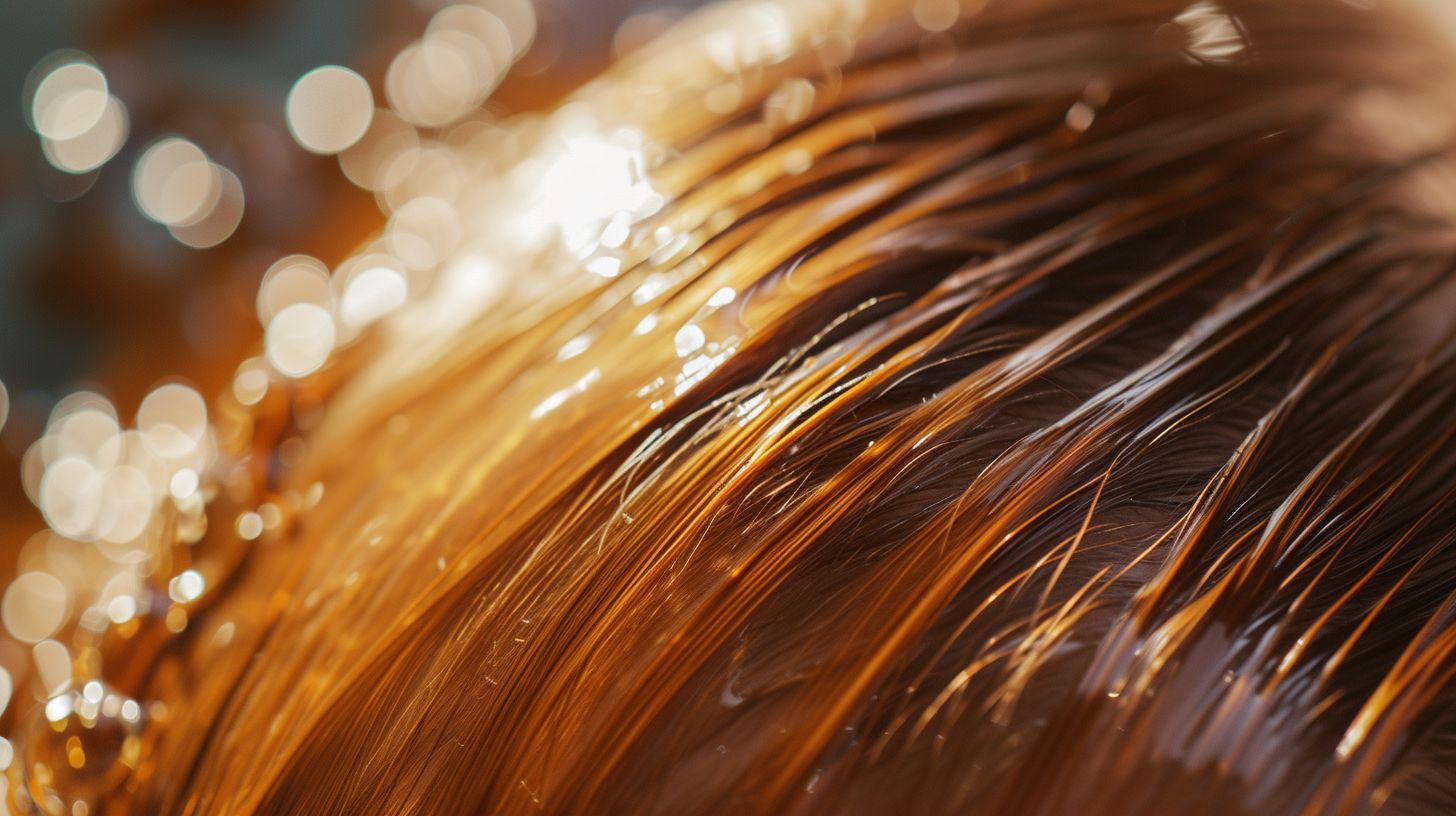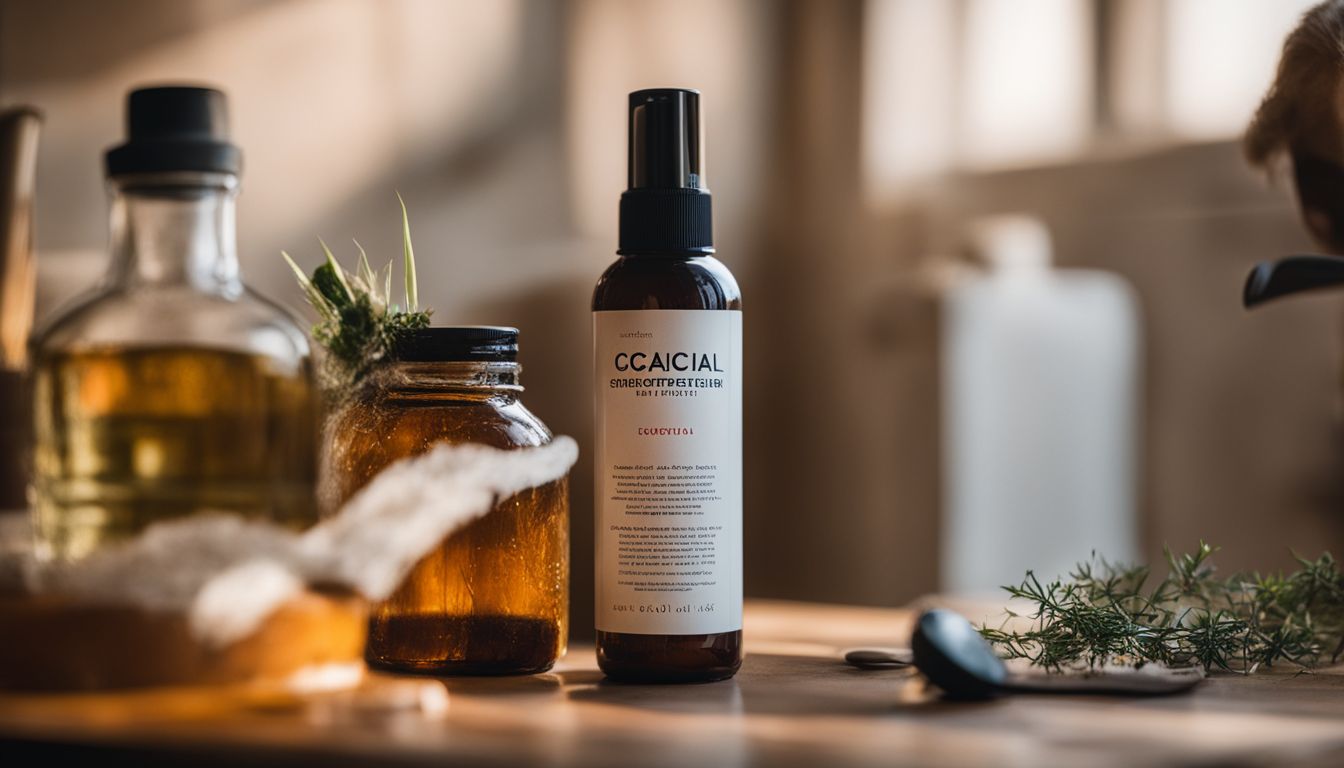


Are you worried about hair loss after using chemical straighteners? Research links these popular beauty treatments to a type of permanent hair loss called cicatricial alopecia. This article will pull back the curtain on how straightening chemicals may damage your scalp, leading to this distressing condition.
Read on for vital information that could save your strands.
Key Takeaways
- Chemical straighteners break down hair bonds, leading to weakened strands and potential scalp damage which can cause cicatricial alopecia, a permanent form of hair loss.
- Cicatricial alopecia is often treated with corticosteroids or immunomodulatory agents, but early detection and appropriate management are critical to prevent irreversible hair loss.
- Frequent use of chemical relaxers has been linked to central centrifugal cicatricial alopecia (CCCA), especially in African American women who may be at higher risk due to particular grooming practices.
- Dermoscopic analysis aids dermatologists in the diagnosis of cicatricial alopecia by identifying specific patterns indicative of this condition.
- Clinical studies and case reports have confirmed the association between chronic use of hair relaxers and increased incidence of scarring forms of alopecia, emphasizing the need for safer hair grooming alternatives.
Understanding Cicatricial Alopecia
Cicatricial alopecia is a group of rare disorders that result in permanent hair loss and scarring of the scalp. It is crucial to understand its classification, features, and available treatment options for those affected by this condition.
Definition and Classification
Cicatricial alopecia, often known as scarring alopecia, is a group of rare disorders that destroy hair follicles. Hair follicles are replaced with scar tissue, which leads to permanent hair loss.
Based on the type of immune cells involved in destroying hair follicles, this condition falls into two main categories: lymphocytic and neutrophilic cicatricial alopecias. Examples within these classes include lichen planopilaris under lymphocytic and folliculitis decalvans under neutrophilic types.
Each variant shows distinct patterns and symptoms affecting diagnosis and treatment approaches. Treatments may vary widely from topical creams to systemic medications like antimalarials or corticosteroids depending on the specific type of disease present.
Accurate classification aids dermatologists in crafting effective treatment plans tailored to individual patient needs, taking into account the varying prognosis associated with each subtype.
Features and Diagnosis
Cicatricial Alopecia reveals itself through symptoms like bald patches, severe itching, and tender scalp. These features often point towards an inflammatory condition that targets hair follicles, leading to irreversible damage and scarring.
A person may experience redness, scaling around the follicle openings or pustules. Central centrifugal cicatricial alopecia (CCCA) is typically noted for its gradual progression from the vertex of the scalp outward.
Diagnosing this complex condition requires a thorough clinical evaluation by a dermatology specialist who will conduct tests such as scalp biopsies to examine tissue samples for signs of scarring and inflammation.
Consistent with CCCA are findings like destroyed hair follicles replaced by scar tissue in histopathological examinations. The diagnostic process might also include blood tests to rule out other autoimmune diseases like cutaneous lupus or lichen planus that present similar symptoms.
To deepen our understanding of how chemical straighteners contribute to these conditions, let’s explore their effects on hair and scalp health next.
Available Treatment Options
Treating cicatricial alopecia involves managing inflammation and preventing further hair loss. Doctors tailor treatment plans to each individual’s condition and the severity of their symptoms. Here are some commonly used approaches:
- Topical corticosteroids help reduce scalp inflammation, allowing hair follicles to recover.
- Injections of corticosteroids directly into affected areas can also decrease inflammation and halt disease progression.
- Systemic corticosteroids may be prescribed for more widespread or severe cases; they work by suppressing the immune system.
- Immunomodulatory agents, such as methotrexate or mycophenolate mofetil, modify immune responses to prevent follicular damage.
- Antimalarial medications like hydroxychloroquine are used for their anti-inflammatory properties, especially in lupus-related skin conditions.
- For stable lesions with no active inflammation, surgical options like scalp reduction surgery can remove scarred areas.
- Hair transplantation may be an option to restore hair in areas where scarring has caused permanent loss.
The Connection Between Chemical Straightening and Cicatricial Alopecia

Chemical straighteners have been linked to the development of cicatricial alopecia, a scarring form of hair loss. Understanding the effects of these products on the hair and scalp is crucial in uncovering the potential dangers associated with chemical straightening.
Effects of Chemical Straighteners on Hair and Scalp
Chemical straighteners work by breaking down the bonds in hair, specifically disulfide bridges, which can lead to serious damage. These treatments reduce cystine content, causing structural harm to each strand.
As a result, hair becomes more fragile and prone to breakage. The reduction in resilience against breakage is not just temporary; it has long-lasting effects on hair health.
Scalp exposure to chemical relaxers often brings about scalp desquamation and allergic reactions among users. Hair loss is also a significant concern as these products weaken hair shafts over time.
For those who combine straightening with coloring procedures, the risk of protein loss during washing increases dramatically—accelerating potential damage even further. Moving forward from understanding the impact on individual hairs and the scalp surface, let’s explore how this connects directly to cicatricial alopecia development.
Link Between Hair Relaxers and Cicatricial Alopecia
Chronic use of hair relaxers can lead to scalp infections and cicatricial alopecia, especially in the vertex of the scalp. This type of scarring hair loss is caused by inflammation that damages and scars the hair follicles, preventing new hair growth.
Hair relaxers have been associated with central centrifugal cicatricial alopecia (CCCA) and an increased risk of traction alopecia. The chemical ingredients in these products may cause damage to the scalp, leading to persistent irritation and inflammation that eventually results in scarring and permanent hair loss.
Understanding how chemical straightening methods impact hair health is paramount for maintaining healthy tresses. Dive into a detailed analysis of acid straighteners – formaldehyde, aldehydes, and formaldehyde derivatives.
Deep Dive into Chemical Straightening Methods

This section explores the various chemical straightening methods such as acid straighteners and hair relaxers, delving into their composition and impact on the hair and scalp. Understanding these methods is crucial in unveiling the potential connection between chemical straightening and cicatricial alopecia.
Acid Straighteners: Formaldehyde, Aldehydes, and Formaldehyde Derivatives
Acid straighteners, containing formaldehyde or glyoxylic acid, can cause long-term damage to the hair. These chemicals are known to weaken the protein structure of the hair shaft, leading to increased susceptibility to breakage and brittleness.
Over time, repeated use of these acid-based straighteners can result in overall hair thinning and loss. The chronic effects of these harsh chemicals can contribute to scalp issues including irritation and potential cicatricial alopecia.
Furthermore, recent regulatory changes have attempted to limit the use of straighteners containing harmful substances like formaldehyde; however, there is a lack of clarity regarding new acid straighteners which pose similar risks without clear regulation.
Such unregulated products increase the likelihood of adverse outcomes on both hair health and scalp integrity.
Hair Relaxers: Composition and Impact
Hair relaxers contain strong chemicals such as sodium hydroxide, guanidine hydroxide, or ammonium thioglycolate. These substances break down the hair’s natural structure, altering its shape and texture.
The impact of these chemical relaxers on the hair shaft can lead to significant damage, including protein loss and breakage. Chronic use of these products has been associated with scalp infections and an increased risk of cicatricial alopecia, a condition characterized by irreversible hair loss due to scarring.
Additionally, some so-called “chemical-free” relaxers have been found to cause severe hair breakage or loss.
Chemical straightening treatments do not only affect the individual strands of hair but also impact the scalp. The chemicals in these products can cause local effects such as burns and irritations when applied incorrectly or left on for too long.
Furthermore, studies have shown that African-American women who use these products are at a higher risk of experiencing systemic effects from their use due to their higher frequency of application and chronic exposure over time.
Primary Cicatricial Alopecia: Diagnosis and Treatment
Upon diagnosis of primary cicatricial alopecia, it is crucial to investigate the underlying causes and review the available treatment modalities for effective management. Understanding the specific features and treatment options for this type of alopecia is essential in providing appropriate care for affected individuals.
Investigating the Underlying Causes
The underlying causes of primary cicatricial alopecia are multifaceted and may involve inflammatory responses, genetics, and environmental factors. Studies have indicated a potential link between the condition and autoimmune diseases such as systemic lupus erythematosus, highlighting the role of immunity in its pathobiology.
Additionally, the microenvironment within hair follicles plays a crucial role in the development of cicatricial alopecia, with disruptions to this niche potentially contributing to its pathology.
Furthermore, research has shown that specific genetic factors may predispose individuals to certain forms of primary cicatricial alopecia. Understanding these underlying causes is essential for developing effective treatment modalities that target not only the symptoms but also the root contributors to this distressing condition.
Review of Treatment Modalities
Chemical straightening can damage the hair shaft and cause increased breakage and irregularities in the hair cuticle. Hair relaxers, particularly those used by African-American women, have been associated with scalp desquamation, hair loss, weakening of the hair, and allergic reactions. The chronic effects of hair relaxers may lead to scalp infections and cicatricial alopecia, mainly in the vertex of the scalp. The use of hair relaxers has been linked to central centrifugal cicatricial alopecia (CCCA) and an increased risk of traction alopecia. Different ethnicities’ hair respond differently to straightening treatments; some studies show a greater susceptibility to damage in Chinese hair compared to Caucasian hair and alterations in Afro hair. The combination of hair dye and straightening treatments can lead to increased protein loss during washing, particularly with the use of sodium hydroxide.
Lymphocytic and Neutrophilic Alopecia: An Overview
Lymphocytic Alopecia and Neutrophilic Alopecia are two different forms of Cicatricial Alopecia that result from inflammation in the scalp. Understanding these specific subtypes is crucial for accurate diagnosis and effective treatment.
Understanding Lymphocytic Alopecia
Lymphocytic alopecia, a form of cicatricial alopecia, involves the attack of hair follicles by lymphocytes, causing scarring and permanent hair loss. This condition is linked to autoimmune processes where the body’s immune system mistakenly targets healthy hair follicles.
The inflammation caused by these attacks results in progressive scarring and eventual hair loss. Some key features of lymphocytic alopecia include redness, scaling, and pustules on the scalp.
The diagnosis is usually made through a scalp biopsy to confirm lymphocyte infiltration into the affected follicles.
Treatment options for lymphocytic alopecia typically focus on reducing inflammation and slowing disease progression. Corticosteroids are commonly used to suppress immune response and reduce inflammation within the affected areas.
Neutrophilic Alopecia: Causes and Treatment
Neutrophilic alopecia, specifically Folliculitis Decalvans, arises from a destructive inflammatory process in the hair follicle. The condition is triggered by the body’s immune response to bacterial colonization of the hair follicles, leading to their irreversible destruction and subsequent replacement with fibrous tissue.
Antibiotics, antiseptics, and topical corticosteroid lotions are primary treatments for Neutrophilic Alopecia as they help control the underlying bacterial infection while reducing inflammation in the affected areas.
These treatments aid in managing symptoms and preventing further progression of this type of cicatricial alopecia.
Folliculitis Decalvans has been linked to various bacteria such as Staphylococcus aureus and other unknown organisms that colonize within the hair follicles, causing persistent inflammation and scarring.
Cicatricial Alopecia from a Dermatological Perspective
Explore the role of dermatoscopy in identifying and diagnosing cicatricial alopecia, as well as understanding the differential diagnosis. Learn about the insights gained from clinical studies and case reports on this condition.
Dermoscopic Findings in Cicatricial Alopecia
Dermoscopic findings in cicatricial alopecia reveal structural changes within the hair shaft, including damage to the cortex and fiber. Additionally, there is an increase in extracted particles, indicating a disruption to the integrity of the hair.
These observations provide crucial insights for dermatologists in diagnosing and monitoring this condition.
The use of hair relaxers in combination with other techniques can contribute to increased vulnerability to damage and may lead to irreversible alopecia. Both lye and no-lye straighteners cause a decrease in cystine, resulting in structural damage to the hair shaft.
Role of Dermoscopy in Differential Diagnosis
Dermoscopy helps dermatologists identify distinct patterns and features of cicatricial alopecia, allowing for more precise differential diagnosis. By revealing characteristic findings like perifollicular hyperkeratosis, follicular erythema, and follicular dropout, dermoscopy aids in distinguishing between scarring and non-scarring alopecia.
Additionally, it assists in monitoring disease progression and evaluating treatment response in patients with cicatricial alopecia.
Moreover, dermoscopy plays a crucial role in differentiating between various types of cicatricial alopecia such as central centrifugal cicatricial alopecia and lichen planopilaris.
Analyzing Clinical Studies and Case Reports
This section will examine the findings of clinical studies on Cicatricial Alopecia and review real-life case reports to provide valuable insights for understanding the condition.
Examination of Clinical Studies on Cicatricial Alopecia
Clinical studies on cicatricial alopecia have highlighted the significant impact of hair relaxers on the development of this condition. Research has demonstrated a clear association between the chronic use of hair relaxers and the incidence of central centrifugal cicatricial alopecia (CCCA).
Furthermore, histopathological examinations have confirmed the link between chemical straightening methods and scalp infections that contribute to cicatricial alopecia. These findings underscore the need for further exploration into preventive measures and alternative hair grooming practices to reduce the risk of developing this debilitating condition.
Moving forward in our discussion, let’s delve into an overview of primary cicatricial alopecia focusing on its diagnosis and treatment options.
Review of Case Reports: Learning from Real-life Instances
Several case reports have shed light on the potential connection between chemical straightening treatments and the development of cicatricial alopecia. These real-life instances have shown that the use of hair relaxers and other straightening methods has been associated with histopathologically confirmed central centrifugal cicatricial alopecia (CCCA) as well as an increased risk of traction alopecia.
Additionally, some cases have indicated that a combination of hair implants and chemical straightening can lead to permanent alopecia in certain individuals, emphasizing the importance of understanding these connections for both healthcare providers and individuals considering such treatments.
Real-life case reports serve as valuable learning opportunities, providing insights into the potential adverse effects of chemical straightening methods on scalp health. The findings underscore the need for further research regarding the long-term impact of these practices on hair and scalp conditions.
Hair Grooming Practices and Central Centrifugal Cicatricial Alopecia
Hair grooming practices can play a significant role in the development of central centrifugal cicatricial alopecia. Understanding how certain hair care routines and techniques may contribute to this condition is essential for preventing and managing its impact on hair health.
Role of Hair Grooming in Cicatricial Alopecia
Hair grooming practices play a significant role in the development and progression of cicatricial alopecia. Chemical straightening, hair coloring, and excessive heat styling can damage the hair shaft and scalp, leading to inflammation and scarring.
The chronic use of harsh grooming techniques, particularly in individuals with curly or coiled hair textures, can exacerbate conditions such as central centrifugal cicatricial alopecia (CCCA) and traction alopecia.
Additionally, the combination of certain relaxers with other chemical treatments may further increase the risk of developing this type of scarring alopecia.
Understanding Central Centrifugal Cicatricial Alopecia
Central Centrifugal Cicatricial Alopecia is a common cause of hair loss in African American women. It typically starts at the crown or central scalp area and spreads outward, leading to permanent hair loss if not treated promptly.
The condition is associated with excessive heat styling, tight hairstyles, and chemical treatments like relaxers. Research indicates that genetics may also play a role in its development, emphasizing the importance of early diagnosis and appropriate treatment strategies.
Furthermore, Central Centrifugal Cicatricial Alopecia can result in scarring of the hair follicles due to inflammation. This scarring leads to irreversible damage and prevents new hair from growing.
Future Perspectives and Research Directions in Cicatricial Alopecia
Future perspectives in cicatricial alopecia include exploring new treatment approaches such as hair cloning and platelet-rich plasma therapy. Research directions focus on understanding the underlying causes of the condition and developing targeted therapies for different subtypes of cicatricial alopecia.
Gaps in Knowledge and Opportunities for Future Research
Current research on the long-term effects of chemical hair treatments is limited, indicating a critical knowledge gap in understanding their impact on alopecia development. Scientifically rigorous studies are imperative to comprehensively assess the potential risks associated with chemical straightening methods and their role in causing cicatricial alopecia.
Furthermore, there is an urgent need for comprehensive investigations into the responses of hair structures to chemical agents, focusing on uncovering specific mechanisms underlying alopecia pathogenesis triggered by these treatments.
Comprehensively evaluating the effects of new “acid straighteners,” such as glyoxylic acid, beyond ANVISA regulations and clarifying their potential impacts on hair health remains an essential area for future research.
Advances in Treatment Approaches
Treatment approaches for cicatricial alopecia have advanced significantly in recent years. New therapies targeting the underlying causes, such as scalp inflammation and hair follicle damage, are showing promising results in clinical studies.
Additionally, there is ongoing research into innovative treatment modalities aimed at reducing the pro-inflammatory response associated with this condition. The development of personalized treatment plans based on individual patient characteristics and genetic factors also holds great potential for improving outcomes in cicatricial alopecia cases.
Moving forward to complete our discussion on understanding cicatricial alopecia, let’s delve into the crucial topic of hair grooming practices and their impact on Central Centrifugal Cicatricial Alopecia (CCCA).
Conclusion.
In conclusion, the potential risks associated with chemical straightening and hair relaxing treatments are significant. Studies have demonstrated that these procedures can lead to scalp inflammation, breakage, diminished hair mass, and irregularities in the hair cuticle.
The chronic effects of such treatments can also result in conditions like central centrifugal cicatricial alopecia (CCCA), particularly prevalent in African American women. Further research is essential to fully understand the extent of damage caused by these practices on both the hair and scalp.
Therefore, it is crucial for individuals to carefully consider these risks before undergoing chemical straightening or hair relaxing procedures.
FAQs
1. What is cicatricial alopecia?
Cicatricial alopecia is a group of rare disorders, including lichen planus follicularis and frontal fibrosing alopecia, causing hair loss where scar tissue replaces the follicles.
2. How might chemical straightening treatments like Brazilian Blowouts cause hair problems?
3. Are there any connections between hair straightening products and certain health conditions?
Some studies suggest that frequent use of chemical straighteners with components like methylene oxide could be linked to inflammatory disorders, which include chronic cutaneous lupus erythematosus and androgenetic alopecia.
4. What are some recommended first-line treatments for those experiencing severe hair loss diseases?
First-line treatments advised by experts often involve medications aimed at reducing inflammation, such as minoxidil for female pattern baldness or finasteride for male pattern baldness.
5. Can lifestyle factors influence the risk of developing scarring types of alopecia?
Yes, aspects like uncontrolled type 2 diabetes mellitus can increase one’s susceptibility to autoimmune conditions associated with cicatricial alopecias, such as genodermatoses or hidradenitis suppurativa.
6. If someone has cicatricial alopecia caused by chemicals, what steps should they take toward recovery?
Discontinuing the use of harsh chemicals on the scalp and seeking advice from specialists affiliated with organizations such as the North American Hair Research Society is essential; these professionals may prescribe treatments like clindamycin or recommend procedures geared towards effective hair restoration.
